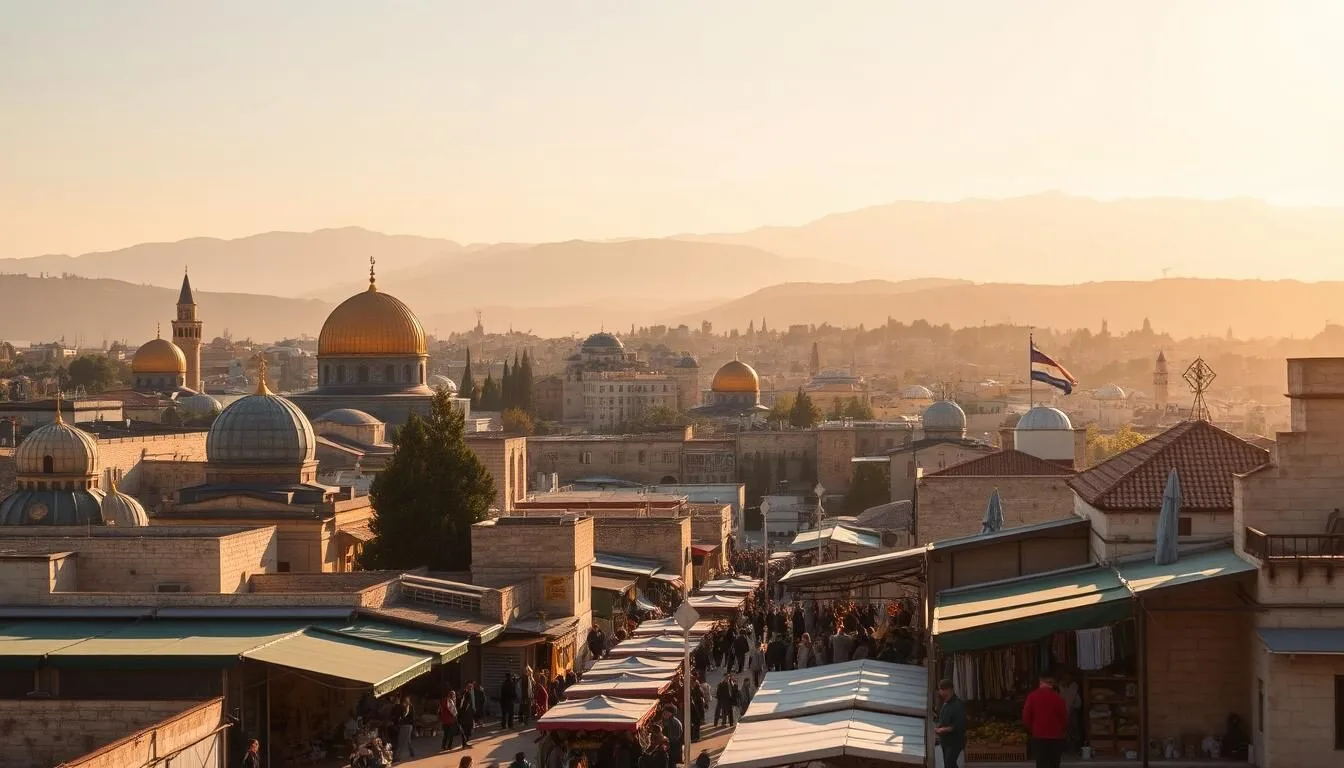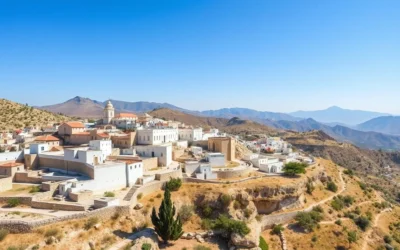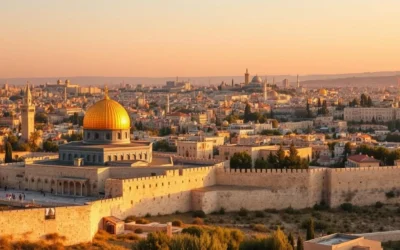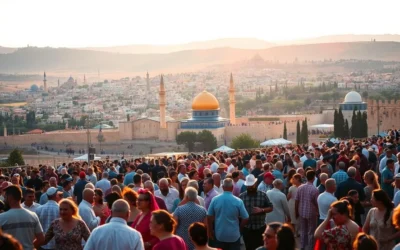✓ Accommodations✓ Flights✓ Rental Cars✓ Tours & Activities
Did you know that the ancient city’s climate varies significantly throughout the year, impacting the quality of your visit? With temperatures ranging from mild to extreme, timing is crucial for an enjoyable experience.
You might be wondering when to visit. The ideal time to visit is during the spring (March to May) and fall (September to November), when daytime temperatures are mild and pleasant.
Understanding Jerusalem’s unique climate, which differs from coastal cities like Tel Aviv due to its elevation, will help you pack accordingly and plan your itinerary. In this guide, we’ll explore the best times to visit based on weather patterns, seasonal events, and practical considerations to ensure your trip is nothing short of amazing.
Understanding Jerusalem’s Climate Throughout the Year
Jerusalem’s climate is distinct due to its geographical position, offering a unique experience compared to other parts of Israel.
Jerusalem’s Unique Mediterranean Climate
Jerusalem enjoys a Mediterranean climate with warm summers and cool winters, making it an attractive destination. Compared to Tel Aviv, Jerusalem’s climate is cooler and drier.
The city’s elevated position results in a drier climate, ideal for tourists seeking comfort. Understanding these regional differences is crucial for planning a trip to Israel.
Regional Climate Differences
Tel Aviv’s coastal location makes it humid, while Jerusalem’s inland position makes it drier. This difference is significant when planning activities or deciding when to visit.
Spring in Jerusalem: March to May
Visiting Jerusalem during spring allows you to enjoy the city’s historic sites in pleasant weather. The season brings mild temperatures and a vibrant atmosphere, making it an ideal time for travel and exploration.
Temperature and Precipitation Patterns
During spring, Jerusalem experiences a significant change in weather patterns. Days are generally warm, while nights can still be cool, especially in March and early April. The average high temperature rises from 18°C (64°F) in March to 25°C (77°F) in May, making it an excellent time to visit before the summer heat sets in.
Spring Festivals and Events
Spring in Jerusalem is a time of various festivals and events, adding to the city’s charm. You can enjoy cultural activities, religious celebrations, and traditional festivities, making your visit even more memorable. The season is filled with sun-filled days perfect for outdoor explorations.
What to Pack for Spring Visits
To make the most of your spring visit to Jerusalem, pack accordingly. Here are some essentials:
- Layered clothing for varying temperatures between morning, afternoon, and evening.
- Lightweight, long-sleeved shirts and pants for sun protection while visiting outdoor archaeological sites.
- A light jacket or sweater for cooler mornings and evenings.
- Comfortable walking shoes for navigating Jerusalem’s historic areas.
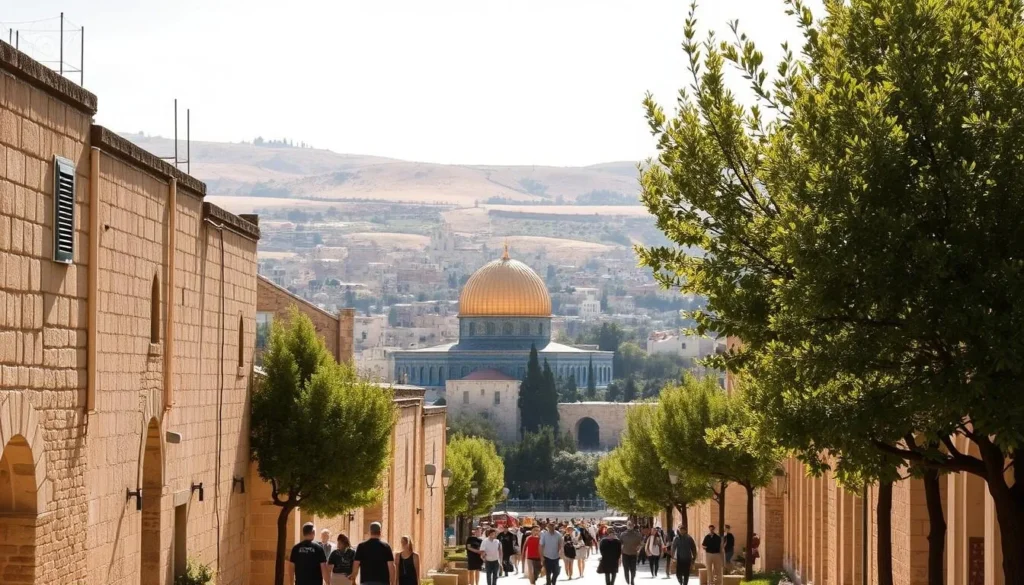
Summer in Jerusalem: June to August
You’ll want to be prepared for the summer heat when visiting Jerusalem. Summer is a peak tourist season, but the scorching temperatures can be challenging.
Dealing with Summer Heat and Sunshine
Summer in Jerusalem is characterized by intense heat and sunshine. To cope with the heat, stay hydrated by drinking plenty of water. It’s also advisable to stay in the shade, especially during the hottest part of the day.
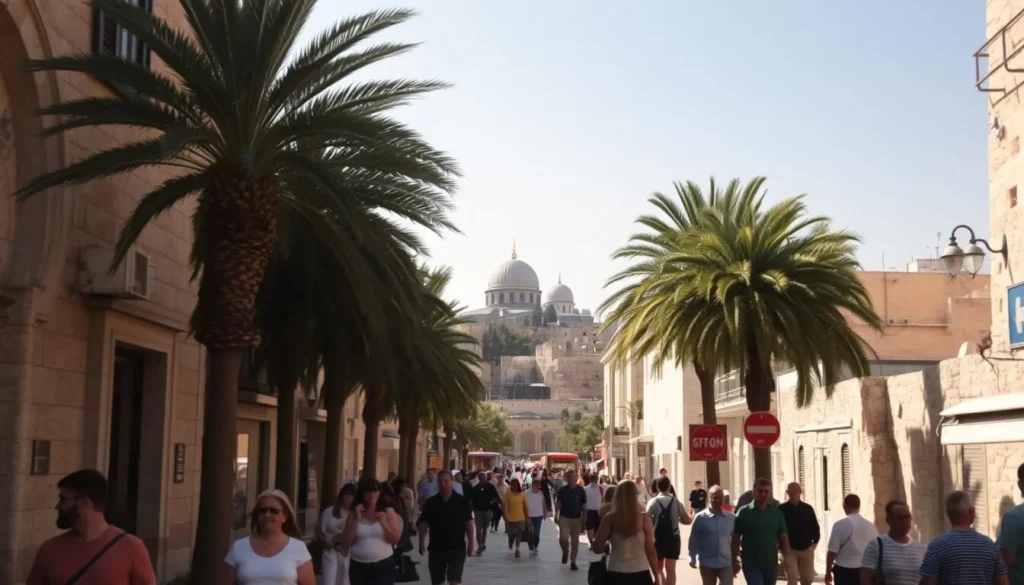
Summer Cultural Events and Activities
Despite the heat, summer in Jerusalem is filled with cultural events and activities. Many outdoor concerts and festivals take place during this time, offering a unique experience. You’ll also find that some hotels and transportation services offer special packages and discounts during the summer months.
Essential Summer Packing List
When packing for your summer trip to Jerusalem, consider including:
- Lightweight, breathable clothing
- Long-sleeved shirts and long pants for sun protection
- A wide-brimmed hat, sunglasses, and high-SPF sunscreen
- A reusable water bottle to stay hydrated
| Item | Purpose |
|---|---|
| Lightweight clothing | Stay cool |
| Long pants | Protect from the sun |
| Sunscreen | Prevent sunburn |
Fall in Jerusalem: September to November
As the summer heat dissipates, fall emerges as a delightful time to visit Jerusalem, offering pleasant weather and a plethora of cultural experiences. The fall season, which spans from September to November, is characterized by comfortable temperatures, making it an ideal time to explore the city’s historic sites.
Weather Conditions and Comfort Levels
During the fall, temperatures in Jerusalem hover around the mid-20’s Celsius (high 70s Fahrenheit) in the highlands and high 20’s Celsius (mid to low 80s Fahrenheit) in the deserts and on the coast. You can enjoy warm weather gear such as shorts, t-shirts, and sandals during the day. However, it’s essential to bring a jumper or light coat for the evenings as temperatures frequently dip to 15°C (59°F).
Jewish High Holidays and Their Impact on Travel
Fall is a significant season in Jerusalem due to the Jewish High Holidays, including Rosh Hashanah and Yom Kippur. These holidays can impact travel plans, as some sites may have restricted access or special visiting hours. It’s crucial to plan your visit accordingly and be respectful of the religious observances.
What to Wear During Fall Visits
When packing for a fall visit to Jerusalem, consider the fluctuating temperatures and the need to dress modestly when visiting religious sites. You should:
- Pack layered clothing to adjust to warm days and cooler evenings.
- Include long pants and long-sleeved shirts for versatility and modesty.
- Bring a light raincoat or umbrella, especially for November visits when rainfall increases.
- Wear comfortable walking shoes, as exploring Jerusalem involves considerable walking on uneven surfaces.
Enjoy your visit to Jerusalem under the pleasant fall weather, with the warm sun during the day and cooler temperatures in the evenings. Planning your trip during this season can be a great time visit Israel, offering a mix of cultural experiences and comfortable exploration conditions.
| Month | Average High Temperature (°C) | Average Low Temperature (°C) | Precipitation (mm) |
|---|---|---|---|
| September | 28 | 18 | 0 |
| October | 26 | 16 | 15 |
| November | 22 | 12 | 50 |
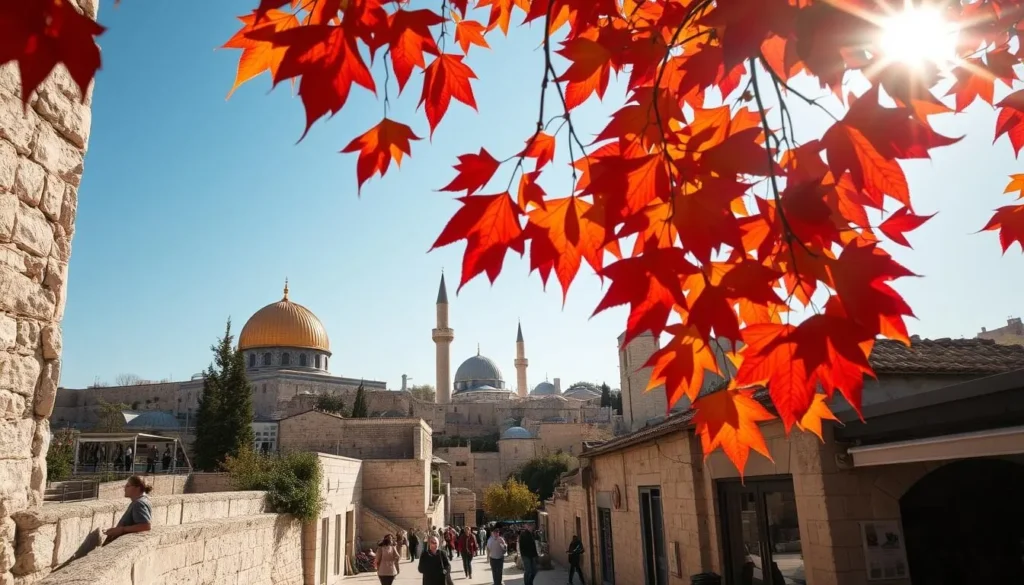
Winter in Jerusalem: December to February
If you’re visiting Jerusalem during the winter months, you’ll need to pack accordingly to stay warm and dry. Winter in Jerusalem is characterized by cool temperatures and significant precipitation.
Temperature Ranges and Precipitation
Expect maximum highs of around 11°C (51°F) in Jerusalem, while Tel Aviv is slightly warmer with an average high of 18°C (64°F). Nighttime temperatures can drop as low as 10°C (50°F) across much of the country. Winter is the wettest season, with most of the annual rainfall occurring during these months.
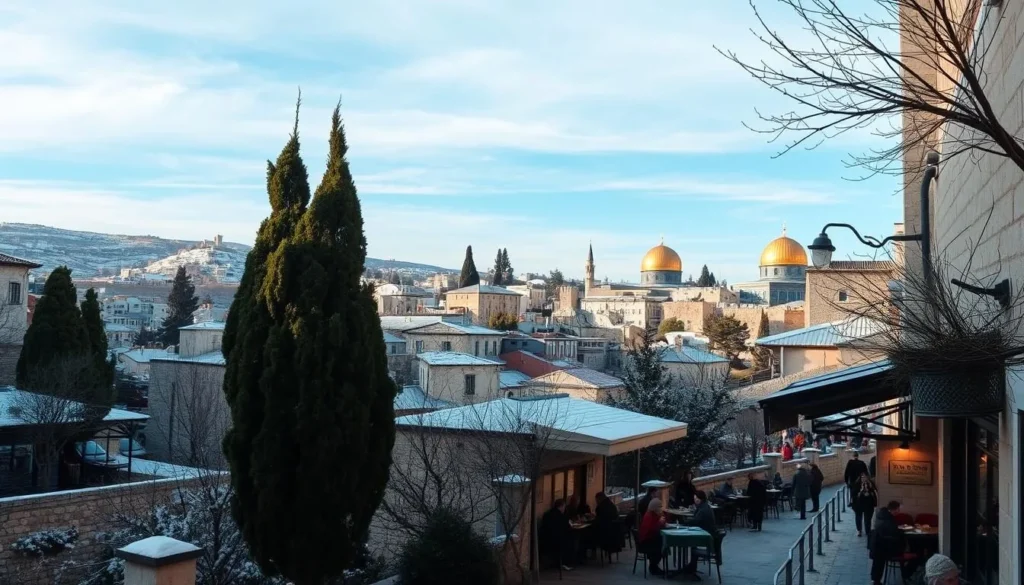
Christmas in the Holy City
For travelers visiting during winter, Christmas celebrations in Jerusalem are a unique experience. Many hotels and local businesses participate in the festive atmosphere, making it a wonderful time to explore the city’s religious sites.
Winter Wardrobe Essentials
To navigate Jerusalem’s winter weather, it’s crucial to pack warm clothing, including a heavy jacket, sweaters, and long pants. Waterproof outerwear and shoes are also essential, given the significant rainfall. Layered clothing is recommended, as indoor spaces are typically well-heated. Don’t forget accessories like scarves, gloves, and hats for early morning or evening activities. When visiting religious sites, ensure your winter wardrobe still meets the modest dress requirements.
When planning your transportation around the city, consider the weather conditions. Some areas may be more challenging to navigate during heavy rainfall.
Jerusalem, Israel: Best Months for a Weather-Savvy Trip
Planning a trip to Jerusalem requires considering the best time to visit to make the most of your experience. The city’s climate and significant events can greatly impact your travel plans.
Ideal Months for Religious Sites
Visiting Jerusalem’s religious sites is a must, and the best times to do so are during the spring (March to May) and autumn (September to November). These periods offer mild weather, making it ideal for exploring the city’s holy places without the extreme temperatures.
Best Times for Outdoor Activities
For those interested in exploring outdoors, the cooler months from October to April are perfect. The weather is more comfortable, allowing for a more enjoyable experience when visiting places like the Dead Sea.
| Period | Weather | Activities |
|---|---|---|
| Spring (Mar-May) | Mild | Explore religious sites, outdoor activities |
| Autumn (Sep-Nov) | Mild | Explore religious sites, outdoor activities |
| Winter (Dec-Feb) | Cold/Rainy | Indoor activities, budget-friendly |
Conclusion: Planning Your Perfect Jerusalem Trip
The best time to visit Jerusalem is a personal choice, influenced by your preferences for weather, crowd levels, and cultural events. Spring (April-May) and fall (September-October) are generally considered ideal due to their balanced combination of pleasant weather, reasonable prices, and manageable crowds.
When planning your trip, consider your priorities: ideal weather conditions, lower costs, specific cultural experiences, or avoiding crowds at major sites. Jerusalem can be enjoyed year-round with proper preparation, as each season offers distinct advantages and challenges for travelers.
To make the most of your visit, plan your itinerary according to the season, and consider combining your Jerusalem visit with trips to other parts of Israel, like Tel Aviv or the Dead Sea. Booking hotels in advance is advisable, especially during major holidays and peak summer months. Flexibility in your travel dates can help you avoid both crowds and higher prices.
—
The above is subject to change.
Check back often to TRAVEL.COM for the latest travel tips and deals.
